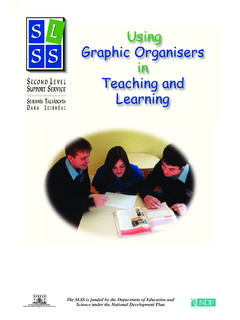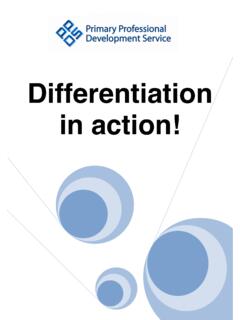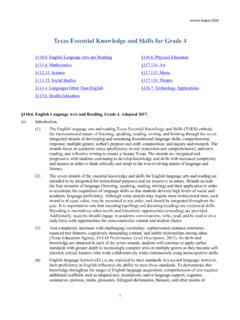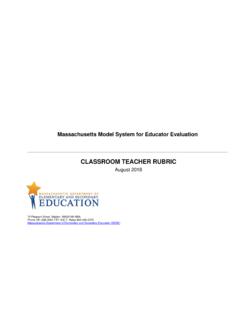Transcription of The Reading Process - PDST
1 1 The Reading Process 2 Introduction Reading is one strand of literacy. The Reading Process is complex and multi-dimensional. Effective teachers have an understanding of this complexity and are able to use a range of teaching approaches that produce confident and independent readers. Recent work completed by the NCCA (Research Report 15, 2012) identified a number of components that need to be considered in the teaching of Reading towards recognizing this complexity. Among these are: the establishment of varied and rich vocabulary development of phonological processes the provision of a framework for teaching comprehension strategies a need to ensure that motivation and enjoyment of Reading are key aspects of the Reading Process a renewed focus on Reading fluency This booklet attempts to highlight the above components by providing some background knowledge on each and by outlining practical opportunities for their application in the classroom.
2 Each component is an essential ingredient of a multi-dimensional definition of Reading and provides guidance for understanding how the Reading Process should be taught. Components of Reading 3 Motivation refers to a child s eagerness and willingness to read. The National Literacy and Numeracy Strategy, Literacy and Numeracy for Learning and Life (2011), states that positive attitude and motivation are vital for progression in literacy and numeracy. It also states that .. all learners should benefit from the opportunity to experience the joy and excitement of getting lost in a book (in both paper based and digital formats) (p.)
3 43). Teachers can promote excitement and motivation to read by providing students with interesting and rich texts choice of text authentic purposes for Reading opportunities to explore, interact and experiment with text. Motivated readers require a safe, supportive classroom environment, one in which both the physical aspects and the culture encourages opportunities to use and combine printed, spoken, visual and digital texts . Students benefit from such an environment that allows them to feel confident in taking risks, in sharing texts , in responding openly to texts and in working collaboratively with each other. Levels of motivation and engagement have been found to predict achievement (Baker & Wigfield, 1999) and as such are key factors in determining children s academic success.
4 They are critical to ensuring children develop both the skill and the will to engage in literacy activities. According to Beers 2003, ..social and emotional confidence almost always improves as cognitive competence improves (2003 ). 4 Fostering an enjoyment of Reading can be achieved in a variety of ways by ensuring a print rich environment: which provides a broad range of Reading material matched to children s stages of development and interests (Lipson, Mosenthal, Mekkelson, & Russ, 2004) choice and control: to self-select books for independent Reading , to self-select topics for writing and to choose activities in response to Reading material.
5 That the children are read to every day using varied voice tones and expressions. optimal challenge in order towards moving children beyond their Zone of Proximal Development (Vygotsky, 1978) opportunities for collaboration and social interaction (Guthrie, et al., 2007). This can occur in several ways: responding personally to texts , sharing likes and dislikes and in recommending books to each other. Other ways of motivating students are outlined in the table below: Ideas for Motivating Students Explanation Reading Time Establish a time for independent Reading DEAR time, USSR time and be a role model for students by sharing your enthusiasm for Reading .
6 Share with pupils which Reading material you enjoy Sharing After independent Reading sessions, allow time for students to share what they have just read with partner/group/class Reading to Students Help students experience a wide variety of texts by Reading many different text forms, authors and genres regularly. It is very valuable to allow time daily where the children are read to for the sheer purpose of enjoyment Using Fads Make literacy links to current fads/trends such as current sporting events Films and TV Provide opportunities for students to explore Reading material related to appropriate films/TV programmes Poetry Ensure a variety of poetry texts is available Inventories/surveys Distribute a questionnaire at the start of the year to help select motivating material based on student s interests Book Discussion Groups Provide opportunities for students to discuss a common text that 5 has been read Class-created Books
7 Make a class book with sections dedicated to favourite jokes, riddles or songs, etc. If your school has been involved in the Write a Book competition, display books from the competition Publicity Campaign Have students create a publicity campaign for a text /author, using posters, written advertisements etc. Different Audiences Pair students with Reading buddies from different class levels Reading Timeline Get students to produce a timeline of their lives naming their favourite texts at different stages throughout their years Read with a Friend Have multiple copies of a text available so friends can read it simultaneously and discuss This Is Your Life Student groups who have read the same text can create a This Is Your Life programme based on a central character.
8 Introduced guests can be other characters from text Lonely texts Display lesser used texts under a banner called Loneliest texts in the Library! An incentive could be offered to students who read and review such texts TV vs. Reading Create a chart recording time students spend Reading vs. watching TV at home. Jointly formulate guidelines for earning incentives, Class Reading time > TV time = Reward! Where in the World Give each student a copy of a world map. Every time they read a text that relates to a country in some way, have students colour in the country. Provide incentives for reaching specified goals, a reward for every five countries coloured, etc.
9 Adapted From First Steps Reading Second Edition 6 Working with unmotivated students Motivation is self-generated and happens within the child; it is not done to the child. (Lyons, 2003, 77). Wood (1998) suggests that how the child views himself as a social being is a crucial determiner of his motivation. Motivation and de-motivation for learning are not simply manifestations of individual cognition but consequences of a complex interaction between the person and the social. In order to work effectively with unmotivated students, teachers should demonstrate that they are genuinely interested in the child, in what he thinks, what he does, what he feels and what he cares about select books and encourage students to write stories that reflect their interests and their level of achievement anticipate students problems and prevent inappropriate behaviours from occurring create a warm supportive interpersonal relationship with the student show a personal interest in children s lives by demonstrating genuine interest, caring.
10 Commitment and concern create learning situations and activities in which children are interested and can meet with success structure the environment to ensure children s success provide opportunities for children to take risks without fear of failure value and praise children s efforts introduce tasks and books in such a way as to challenge and entice the children to become involved expect children to succeed Useful Websites #books 7 Fluency is the ability to read aloud with expression to demonstrate an understanding of the author s message (Department of Education and Training in Western Australia, 2004, ) According to Mc Kenna & Stahl (2009) the three key components of Reading fluency are accurate word recognition automaticity appropriate rhythm and intonation of speech.


















